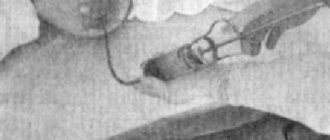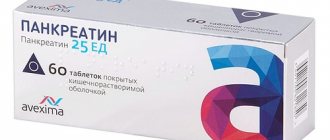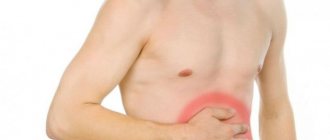Ultrasound picture of the stomach and esophagus
In order to be well versed in the results of an ultrasound scan of the stomach and esophagus, it is necessary, first of all, to know the anatomy of these organs, which we will briefly present below.
Anatomy of the stomach and esophagus
The esophagus is a hollow tube that extends from the pharynx to the stomach. The esophagus is conventionally divided into three parts - the upper, middle and lower thirds, and the boundaries of each part are physiological narrowings of the organ. Thus, the upper third of the esophagus begins from the pharynx and continues to the level of the second physiological narrowing, which lies at the level of the division of the trachea into the right and left main bronchus. The middle third of the esophagus (thoracic part) continues from the second physiological narrowing to the level of the diaphragm. Finally, the lower third of the esophagus (the abdominal part) extends from the level of the diaphragm to its connection with the stomach.
The stomach is located in the upper abdomen between the esophagus and duodenum (see Figure 1). The area where the stomach connects to the esophagus is called the cardiac part (or simply cardia), the upper part is the fundus of the stomach. Below the bottom is the body of the stomach, which passes into the pyloric (pyloric) part. The pyloric part, in turn, consists of the pyloric cave (sinus) and the pyloric canal. The cardia, fundus and body of the stomach form the digestive sac, and the cave and the pyloric canal form the evacuation canal.
In the stomach itself, there are anterior and posterior walls. The anterior wall of the stomach is in contact with the diaphragm, the anterior abdominal wall and the lower part of the liver. The posterior wall of the stomach is adjacent to the aorta, pancreas, spleen, upper pole of the left kidney and left adrenal gland, partially to the diaphragm and transverse colon. The lesser curvature is located on the anterior wall of the stomach, and the greater curvature is located on the posterior wall. The shape of the stomach varies depending on age, gender, its location, filling, and functional state. However, normally the stomach most often has the shape of either a horn or a hook. The size of the stomach also varies - its length is normally 20 - 25 cm, width - 12 - 14 cm, length of the lesser curvature - 18 - 19 cm, length of the greater curvature - 45 – 56 cm, wall thickness – 2 – 5 cm, and capacity – 1.5 – 3 liters.
Ultrasound indicators of the stomach and esophagus
The esophagus is visible in the form of a tube with characteristic physiological narrowings. Normally, the tube should have a uniform wall, without bulges, fluid accumulations, thickenings, etc. The wall of the esophagus has a thickness of about 6 mm. The abdominal part of the esophagus is clearly visualized, visible as a tube with an outer hypoechoic muscle layer and an inner hyperechoic mucous membrane. The diameter of the abdominal esophagus must be measured, which is normally 5–10 mm in children and adolescents, and more than 10.5 mm in adults. When a peristaltic wave or food passes, the lumen of the esophagus opens by 1–2 mm. The stomach is scanned on an empty stomach, without a water-siphon test. During the scan, the position and shape of the stomach, the fluid content on an empty stomach, the condition of the walls, peristalsis and evacuation capacity must be determined. You should know that in a lying position it is possible to fully see the entire stomach only in thin patients, and in people with a heavy build or overweight it is possible to visualize only the outlet of the stomach and its connection with the duodenum. The connection between the stomach and intestines has a characteristic “hourglass” appearance.
With the patient lying on his side, one can also examine the lesser and greater curvature, the pyloric part of the stomach, and the fundus of the stomach. Normally, the stomach is located under the lower edge of the liver. The position of the stomach is determined by the lower border of the greater curvature and the pylorus, which is clearly visible on ultrasound and can have a different position, depending on the posture and physique of the patient. In people with a normal (normosthenic) physique, in the lying position the pylorus is usually located above the navel, and in the standing position it lowers by about 3 - 5 cm. The pylorus is usually visible on ultrasound in the form of a round formation with a diameter of 2 - 2.5 cm with walls 4 - 5 cm thick. 5 mm, with a hypoechoic peripheral rim and an echogenic central part. The peripheral rim reflects the wall of the stomach, and the central part reflects the folds of the mucous membrane. During the study, due to peristaltic contractions, the shape of the stomach and the thickness of its walls are constantly changing. During ultrasound, various parameters of an empty stomach are measured, which are normally the following:
- outer cross-sectional diameter of the gastric outlet – 14 – 21 mm;
- wall thickness of the gastric outlet – 4 – 5 mm;
- the distance between the walls of the outlet of the stomach is 5 – 10 mm;
- length of the gastric outlet – 42.8 ± 1.9 mm;
- image coefficient (ratio of wall thickness to the minimum distance between walls) – 0.4 – 1.0;
- the lower border of the greater curvature of the stomach in the supine position is 63.7 ± 3.9 mm above the navel;
- the pylorus of the stomach in the supine position is 67.5 ± 5.4 mm above the navel;
- the pylorus of the stomach in standing and sitting positions is 46.2 ± 3.6 mm above the navel;
- the lower border of the greater curvature of the stomach in standing and sitting positions is 37.6 ± 2.9 mm above the navel;
- the pylorus in the supine, standing and sitting position - 30 - 40 mm to the right of the midline of the abdomen;
- angle of the stomach – 45 – 70 o.
Normally, on an empty stomach, the stomach can contain up to 40 ml of liquid, which indicates a normal evacuation function. If the liquid in the stomach contains more than 40 ml, this indicates a violation of the evacuation function, which may be caused by gastric atony, pyloric stenosis, pyloric spasm. After filling the stomach with water, when performing an ultrasound with a water-siphon test, the organ takes on an oval-elongated or pear-shaped shape. Stretching the stomach with water allows you to study in more detail the uniformity and thickness of the walls, as well as evaluate peristalsis. At the same time, pay attention to the size and shape of the stomach cavity, monitor the depth, frequency and periodicity of peristalsis waves. After taking the liquid, an ultrasound scan shows anechoic water in the stomach, hyperechoic moving air bubbles in it, as well as three layers of the organ wall. The inner mucosa and outer serous membranes form, as it were, two hyperechoic lines, between which lies the hypoechoic contents of the muscular layer. The normal parameters of a water-filled stomach, measured during ultrasound, are as follows:
- the lower border of the greater curvature of the stomach in the supine position is 33.1 ± 3.5 mm above the navel;
- the pylorus of the stomach in the supine position is 45.6 ± 3.8 mm above the navel;
- the pylorus of the stomach in standing and sitting positions is 24.7 ± 3.1 mm above the navel;
- the pylorus in the supine, standing and sitting position - 40 - 50 mm to the right of the midline of the abdomen.
If, according to ultrasound data, a thickening of the wall of an empty or water-filled stomach of more than 5 mm is detected, then the localization of such an area, its maximum thickness, the shape and outline of the external and internal contours, the distance between the walls in the area of this area, the presence of layering of the wall, its uniformity and echogenicity. It is also necessary to determine the presence of free or encysted fluid, gas near the affected area, pain or sensitivity when pressing the sensor on the skin over the pathological focus.
Normal ultrasound of the stomach
The conclusion of an ultrasound of a normal unaffected stomach must indicate that there is no pathological symptom of the affected organ, the accumulation of free fluid is not detected. The conclusion of an ultrasound of a normal esophagus indicates the thickness of its walls, the absence of bulges, neoplasms and signs of an inflammatory process.
Anatomy of the stomach, structure of the stomach, treatment of the stomach
The stomach is a hollow organ that is adapted for filling with food, initial digestion of food, partial absorption of nutrients with further evacuation of the contents into the duodenum. The stomach is located in the upper part of the abdominal cavity, under the diaphragm, mostly to the left of the midline.
The shape and volume of the stomach depend on the tone of its muscles, on its filling with food, on the condition of neighboring organs, and on the position of the body. In the upper part of the stomach the esophagus flows into it, in the lower part the duodenum departs from the stomach.
The stomach has four parts:
- The cardial part of the stomach is located above and adjacent to the opening from the esophagus to the stomach, which is called the “cardia”
- The fundus or fornix is the part of the stomach that is located at the top and forms a kind of dome.
- The body of the stomach is the main middle part of the stomach
- The pyloric or pyloric part is located at the entrance to the duodenum, where the sphincter is located, which regulates the flow of food into the duodenum - pylorus
The stomach wall consists of four layers:
- mucous membrane
- submucosal layer
- muscle layer
- outer serous membrane
Stomach mucosa
The gastric mucosa is a layer on top of which there are cylindrical epithelial cells, under which there is loose connective tissue and then a thin layer of smooth muscle. The loose connective tissue of the mucous membrane contains the glands of the stomach.
There are three types of cells that form these glands. Some of them are called the main ones. These glands produce pepsinogens and chymosin. The next type of cells is called parietal or parietal cells. They produce the synthesis of hydrochloric acid and gastromucoprotein. The third type of cells are accessory cells or mucocytes. They produce mucoid secretion. In the area of the pylorus (pylorus) there are hormonally active cells. These cells synthesize gastrin.
The gastric mucosa also contains a huge amount of other producing biologically active substances. The role of some of them still remains not fully understood. A very important function of the glandular cells of the stomach is the formation of a protective mucous barrier. Continuous synthesis of gastric mucus is required, which is produced by mucus-forming cells.
This function is stimulated by the activating effect of the autonomic nervous system, insulin, serotonin, and prostaglandins. The secretion of mucus increases under the mechanical influence of parts of the food bolus that irritate the gastric mucosa. Some medications reduce the mucus-forming function: aspirin (acetylsalicylic acid), non-steroidal anti-inflammatory drugs, etc.
There are contraindications. Read the instructions or consult a specialist.
Cost of ultrasound of the stomach at the EMC clinic.
Pathology of the stomach and esophagus on ultrasound
Types of pathological changes in the stomach on ultrasound
Despite the difficulties of visualizing the stomach on ultrasound, due to the presence of a cavity in the organ, the accumulation of gases and the constantly changing shape due to peristalsis, the sonography method allows one to obtain fairly extensive and high-quality information about the condition of the stomach, on the basis of which various pathologies are identified.
Ultrasound signs of gastric pathology are the following:
- change in organ shape;
- change in the diameter of the gastric lumen;
- change in wall thickness;
- the presence of irregularities on the inner or outer surface of the stomach wall;
- the presence of bulges on the wall of the stomach;
- lack of peristalsis;
- presence of antiperistalsis.
The main sign of stomach pathology is thickening of its walls and expansion/narrowing of the lumen of the organ. Thickening of the walls of the stomach with a characteristic uneven echogenicity, when the outer part of the wall is hypoechoic compared to the hyperechoic inner part, is called a symptom of damage to a hollow organ. Currently, in the world medical literature, the terms “target”, “lesion halo”, “pseudo-kidney”, “bull’s eye”, “pathological type of cockade” are also used as synonyms for the term “symptom of lesion of a hollow organ”. All of the above terms refer to the same pathological condition of the stomach, and therefore can be used as equivalent. However, in the countries of the former USSR, the most commonly used term is “symptom of an affected hollow organ,” which we will also use.
Thus, thickening of the stomach wall, as a symptom of an affected hollow organ, can be diffuse and limited. With diffuse thickening, ultrasound shows an increase in wall thickness along its entire length. And with limited thickening, the wall of the stomach turns out to be thicker than normal only in a certain limited area. Unfortunately, the two main pathological signs of stomach diseases detected by ultrasound, namely the symptom of the affected hollow organ and the expansion/narrowing of the organ lumen, are nonspecific. This means that these pathological signs are inherent in many diseases, as a result of which it is impossible to accurately diagnose using ultrasound data alone.
In order to correctly diagnose a person’s existing stomach disease and choose one of the many pathologies that are characterized by a symptom of an affected hollow organ or a change in the lumen of the organ, it is necessary, in addition to the ultrasound results, to also evaluate the clinical symptoms that worry the patient. Only a combination of pathological changes on ultrasound with clinical symptoms will help make the correct diagnosis. Below, for general orientation in the problem, we will provide a table in which we will indicate which diseases of the stomach are characterized by the presence of symptoms on ultrasound of the affected hollow organ and changes in the lumen of the organ.
| Diseases characterized by an ultrasound symptom of an affected hollow organ with diffuse wall thickening | Diseases characterized by an ultrasound symptom of an affected hollow organ with limited wall thickening | Diseases that are characterized by narrowing or widening of the lumen of the stomach cavity on ultrasound |
| Swelling of the stomach wall | Pyloric stenosis | Scar stricture |
| Chronic gastritis type B | Ulceration of carcinoma | Inflammatory stenosis |
| Ménétrier's disease | Stomach ulcer | Tumor-induced stenosis |
| Infiltrative carcinoma | Varicose veins | Impaired evacuation of gastric contents |
| Malignant lymphoma | Gastric carcinoma |
Swelling of the stomach wall can be observed in acute pancreatitis, nephrotic syndrome, congestive heart failure, as well as protein deficiency in the body. Pyloric stenosis can be congenital or acquired due to inflammation, ulcers or tumors.
Ultrasound picture for various diseases of the stomach
Currently, there are six main pathological processes of the stomach that can be accurately diagnosed using ultrasound - these are erosive and ulcerative lesions, polyps, pyloric stenosis, duodenogastric reflux, malignant tumors and malformations. Below we present the characteristic features of the ultrasound picture for the six different above-mentioned pathologies of the stomach, as well as damage to the organ.
Ultrasound picture of the developmental defect “pyloric stenosis”. With congenital pyloric stenosis, a baby develops persistent vomiting of gastric contents at 2–4 weeks of life. Ultrasound shows a pronounced symptom of the affected hollow organ, namely: sharp thickening of the walls in the antrum, narrowing of the walls in the central part and the general appearance of the stomach as an “hourglass”, as well as the presence of contents in the stomach more than 24 hours after eating. Ultrasound picture with the developmental defect “duplication of the stomach” Using an ultrasound, it is possible to establish a doubling of the stomach only by performing a water-siphon test so that both cavities are filled with water and the doctor can clearly see them. A diverticulum is an area of protrusion in the wall of an organ.
Such diverticula can be single or multiple; on ultrasound they are visible only during a water-siphon test, when their lumen is filled with water and makes them visible. A diverticulum filled with water is an anechoic formation of any shape, bulging away from the wall of the stomach and connected to its cavity by a thin stalk. Damage to the stomach usually occurs due to mechanical impacts on the area where the organ is located, for example, from blows to the stomach, a fall from a height onto the stomach, etc. Such damage to the stomach can manifest itself as bruises, tears and ruptures of the walls of the organ. Less commonly, there are injuries caused by chemical substances, the picture of which on ultrasound is different from mechanical injuries.
Gastric contusion is characterized by limited, weakly echogenic thickening or bulging of the wall in the area of injury. The bruise is better visible when performing a water-siphon test than on an empty stomach. A rupture of the stomach wall is characterized by an uneven contour of the walls and their interruption in the area of \u200b\u200bthe rupture. When performing a water-siphon test, a rupture is easily diagnosed, since an ultrasound immediately shows the place where water leaks into the abdominal cavity. Chemical damage to the stomach wall is characterized by its thickening and doubling of the contour (an echo-negative stripe on the outside and an echo-positive stripe on the inside).
If, as a result of the damage, a cicatricial narrowing of the stomach cavity has developed, then an ultrasound will reveal fluid and food debris taken more than 14 hours ago. A gastric ulcer on an ultrasound looks like a hyperechoic thickening of the wall with its deformation and narrowing of the lumen. In addition, an excess amount of fluid on an empty stomach is recorded, a symptom of damage to a hollow organ. The following sizes of various parts of the stomach according to ultrasound are characteristic:
- outer diameter 16 – 22 mm;
- thickening of the wall of the gastric outlet from 6 to 10 mm;
- the distance between the walls in the thickening area is 7 – 12 mm;
- image factor 0.5 – 3.3 mm.
When performing a water-siphon test for a stomach ulcer, the following symptoms are characteristic:
- a clear, uneven contour of the wall in the area of the ulcer with hyperechoic inclusions;
- uneven thickening of the internal hyperechoic layer of the stomach up to 2 – 4 mm;
- the wall thickness in the area of ulcer or erosion is always more than 5 mm;
- indistinct layering of the wall in the area of the ulcer;
- inactive peristalsis.
Ultrasound picture for gastritis The walls of the stomach are evenly thickened, their echogenicity is uneven, with alternating hypoechoic and hyperechoic areas, more than 40 ml of fluid is detected in the cavity on an empty stomach, the diameter of the pylorus is more than 10 mm, signs of duodenogastric reflux. Stomach peristalsis is sluggish. Menetrier's disease is a giant hypertrophic gastritis, in which the gastric mucosa forms huge folds with polyp-like growths. Ultrasound shows a highly thickened wall with uneven echogenicity. Peristalsis is sluggish. A large amount of liquid and food taken more than 14 hours ago is found in the stomach.
A typical symptom is a lesion of a hollow organ with a thickening of the wall in the area where the polyp is located up to 20–28 mm, and a gap between the walls in the area of the thickening of 3–12 mm. There is also an uneven structure of the stomach wall in the area of thickening, the image coefficient in the area of the polyp is 0.9 - 9. The amount of fluid in the stomach on an empty stomach is normal. When performing a water-siphon test on ultrasound, a polypoid bulging of the wall into the lumen of the stomach is clearly visible. The structure of the polyps is heterogeneous, there is no layering.
Ultrasound picture for malignant tumors of the stomach
There is always a symptom of damage to a hollow organ above the area where the tumor is localized. The wall is thickened unevenly (from 10 to 30 mm), the thickening area is hypoechoic, heterogeneous, with impaired layering. The outer contour of the stomach wall in the area where the tumor is located is uneven, but clear. The lumen of the stomach in the tumor area is 2 – 16 mm. The lower border of the greater curvature of the stomach is lower than normal. The amount of fluid in the stomach on an empty stomach is either within normal limits or slightly increased. When performing a water-siphon test, uneven filling of the cavity with water and its insufficient expansion are noted. Rigidity of the thickened wall and sluggish peristalsis are also characteristic. The internal contour of the stomach is hyperechoic, fragmented and thickened more than 3 mm. In the area of the tumor, the outer and inner contours of the stomach are uneven, but clear. Pyloric stenosis is a narrowing of the outlet of the stomach, due to which the evacuation of food masses into the duodenum is impaired.
The causes of pyloric stenosis are usually tumors or a long course of a peptic ulcer, as a result of which scars are formed that tighten the walls of the stomach and reduce the lumen of its pyloric part. Pyloric stenosis is characterized by a shapeless hyperechoic formation with a sharp narrowing of the lumen of the affected area. At the initial stage, the walls of the stomach are thickened, but then they become thinner and the cavity expands. An ultrasound shows that the stomach is dilated and filled with contents of different ages. The amount of fluid on an empty stomach is more than normal, and there is sediment in it. The lower limit of the greater curvature of the stomach is significantly lower than normal. Peristalsis is either absent or weak. In the area of stenosis there is a symptom of damage to a hollow organ, and the wall is thickened to 7 - 22 mm, it has no layering, and the image coefficient is 0.6 - 8.5. When performing a water-siphon test for pyloric stenosis, the patient can only drink a small amount of liquid – no more than 300 ml, due to a feeling of fullness in the abdomen, nausea and sometimes vomiting. When liquid enters the stomach, its contents are mixed and sediment floats to the surface.
The lower border of the greater curvature drops even lower than when examined on an empty stomach. Peristalsis is sluggish or absent. It is impossible to visualize the normal layering of the stomach wall in the area of stenosis. Duodenogastric reflux is a pathological condition in which the contents of the duodenum are refluxed into the stomach. Reflux is detected during a water-siphon test, and on an empty stomach it can be seen on an ultrasound only if there is an accumulation of fluid in the patient’s stomach in an amount greater than normal. On ultrasound, reflux is visible by the retrograde movement of hyperechoic particles from the duodenum up the stomach after filling it with water. The presence of fluid in the stomach on an empty stomach in an amount of more than 40 ml may indicate a peptic ulcer, gastritis, pyloric stenosis or a malignant tumor. In order to understand exactly what disease the fluid in the stomach indicates in a particular case, you need to take into account other signs on ultrasound, as well as the clinical symptoms that the person has.
Pathological changes in the esophagus and ultrasound images in various diseases
Pathological changes in the esophagus on ultrasound are changes in the diameter, wall thickness, length of the abdominal organ, as well as the angle of His. Let's consider what ultrasound signs are characteristic of various pathologies of the esophagus. GER is a pathological reflux of stomach contents into the esophagus. And GERD is damage to the lining of the esophagus due to reflux. GER and GERD are characterized by expansion of the lumen of the esophagus on ultrasound and thickening of its wall. Chalazia is weak peristalsis, as a result of which food stagnates in the esophagus, moving only under the influence of gravity.
On ultrasound, chalazia of the esophagus is characterized by expansion of the lumen of the organ and thickening of its wall. Chalazia cardia is characterized by a gaping of the distal esophagus up to 6–14 mm, as well as visible flow of stomach contents into the esophagus. Cardiospasm is a pathological increase in the tone of the esophagus, as a result of which food does not move well to the stomach. Cardiospasm on ultrasound is characterized by expansion of the thoracic esophagus and at the same time a sharp narrowing of the esophageal-gastric junction to 3 - 5 mm. Stagnant contents are visible in the lumen of the esophagus, the wall of the organ is slightly thickened.










